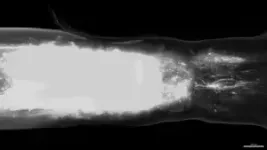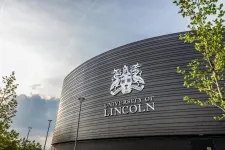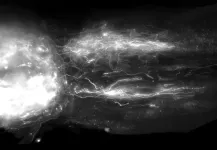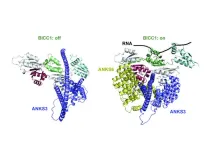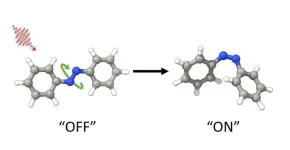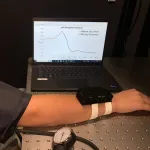(Press-News.org) Immunotherapy, which uses the body’s own immune system to fight cancer, is an effective treatment option, yet many patients do not respond to it. Thus, cancer researchers are seeking new ways to optimize immunotherapy so that it is more effective for more people. Now, Salk Institute scientists have found that manipulating an early step in energy production in mitochondria—the cell’s powerhouses—reduces melanoma tumor growth and enhances the immune response in mice.
The study, published in Science on September 21, 2023, revealed that when electrons take one of two initial routes through mitochondria, genes and proteins become activated that are needed for immune cells to recognize and kill tumor cells.
“We wanted to better understand how tumors acquire the metabolic state that gives them a growth advantage as well as an ability to evade the immune system, which I call the ‘double whammy,’” says Professor Susan Kaech, the paper’s co-senior author and director of the NOMIS Center for Immunology and Microbial Pathogenesis. “And we found a way to make the tumors more recognizable by the immune system and potentially more responsive to immunotherapy.”
It was previously thought that cancer cells do not rely heavily on mitochondria despite still having oxygen and sugars available to them to fuel mitochondrial metabolism. This hypothesis dominated the field of cancer metabolism until recently, when scientists found that mitochondria actually play multiple important roles in tumor growth.
“There's an explosion of recent research activity from my lab and others revealing how mitochondria regulate the immune system and inflammation, and this study highlights an exciting new chapter in this story,” says Professor Gerald Shadel, co-senior author, holder of the Audrey Geisel Chair in Biomedical Science, and director of the San Diego Nathan Shock Center of Excellence in the Basic Biology of Aging.
Kaech and Shadel teamed up to better understand how mitochondria influence both tumor growth and the way in which the immune system recognizes and responds to cancer. For this study, their labs altered a key step in the electron transport chain, a process that moves electrons through mitochondria, leading to the production of adenosine phosphate (ATP), the main energy-providing molecule in cells.
There are two primary routes by which electrons flow inside mitochondria to initiate ATP production. When the team forced electrons to primarily go through only one of these two routes, it led to the overproduction of a metabolite called succinate. This accumulation of succinate led to expression of immune genes in the nucleus and increased the levels of a protein called MHC on the surface of the tumor. In turn, elevated levels of MHC made the tumor cells more visible to specialized immune cells called “killer” T cells, which recognize and eliminate cancer cells.
While the team knew that the metabolic state of tumor cells dictated their enhanced growth properties, this new finding shows that relatively simple manipulations to mitochondrial electron transport can convert a tumor that is evading immune detection into one that is now highly susceptible to immune system attack.
"We were surprised to find that mitochondrial activity determines how susceptible a tumor is to being recognized by the immune system,” says co-first author Kailash Chandra Mangalhara, a senior research associate in Shadel’s lab.
The researchers plan to explore ways to leverage this mechanism to fight cancer without harming mitochondria, which can have adverse effects on normal cells. They will continue to study the role of mitochondrial metabolism in cancer, immune responses, and immunotherapy efficacy.
“We think we found a novel mechanism by which antigen presentation in tumor cells is regulated,” says co-first author Karthik Varanasi, a postdoctoral research associate in Kaech’s lab. “These findings change how we now think about future treatment strategies.”
Other authors include Melissa A. Johnson, Mannix J. Burns, Gladys R. Rojas, Pau B. Esparza Moltó, Alva G. Sainz, Nimesha Tadepalle, Guarav Mediratta, Dan Chen, Yagmur Farsakoglu, Filipe Araujo Hoffmann, Bianca Parisi, and Diana C. Hargreaves of Salk; Keene L. Abbott, Matthew G. Vander Heiden, and Tenzin Kunchok of the Massachusetts Institute of Technology; Mercedes Rincon of the University of Colorado Anschutz; and Marcus Bosenberg of the Yale University School of Medicine.
The research was supported by the National Institutes of Health (R01CA216101, R01CA228211, R35CA242379, R21AI151562, F31CA271787, T32GM007287, F31AG062099); the National Science Foundation (DGE-1122374); a Fundación Alfonso Martín Escudero research fellowship; a Paul F. Glenn Center for Biology of Aging Research postdoctoral fellowship; NOMIS Center postdoctoral fellowships; and the Conrad Prebys Foundation.
About the Salk Institute for Biological Studies:
Unlocking the secrets of life itself is the driving force behind the Salk Institute. Our team of world-class, award-winning scientists pushes the boundaries of knowledge in areas such as neuroscience, cancer research, aging, immunobiology, plant biology, computational biology, and more. Founded by Jonas Salk, developer of the first safe and effective polio vaccine, the Institute is an independent, nonprofit research organization and architectural landmark: small by choice, intimate by nature, and fearless in the face of any challenge. Learn more at www.salk.edu.
END
Rewiring tumor mitochondria enhances the immune system’s ability to recognize and fight cancer
Salk scientists discover in mice that fine-tuning how electrons flow through mitochondria could lead to more effective immunotherapies
2023-09-21
ELSE PRESS RELEASES FROM THIS DATE:
Two studies indicate CO2 on Europa’s surface originated from within the moon’s internal ocean
2023-09-21
A pair of independent studies, using recent James Webb Space Telescope (JWST) observations of carbon dioxide (CO2) ice on Jupiter’s moon Europa, indicate the CO2 originates from a source within the icy body’s subsurface ocean. The findings from both research groups provide new insights into the poorly known composition of Europa’s internal ocean. Beneath a crust of solid water ice, Jupiter’s moon Europa is thought to have a subsurface ocean of salty liquid water. Because of this, Europa is a prime target in the search for life elsewhere in the Solar System. Assessing this deep ...
Global study reveals extensive impact of metal mining contamination on rivers and floodplains, suggesting need for new safeguards to address spike in demand for ‘green’ minerals
2023-09-21
A groundbreaking study, published today in Science, has provided new insights into the extensive impact of metal mining contamination on rivers and floodplains across the world, with an estimated 23 million people believed to be affected by potentially dangerous concentrations of toxic waste.
Led by Professors Mark Macklin and Chris Thomas, Directors of the Lincoln Centre for Water and Planetary Health at the University of Lincoln, UK – working with Dr Amogh Mudbhatkal from the University’s Department of Geography – the study offers a comprehensive understanding of the environmental and health challenges associated with metal mining activities.
Using ...
Regeneration across complete spinal cord injuries reverses paralysis
2023-09-21
When the spinal cords of mice and humans are partially damaged, the initial paralysis is followed by the extensive, spontaneous recovery of motor function. However, after a complete spinal cord injury, this natural repair of the spinal cord doesn’t occur and there is no recovery. Meaningful recovery after severe injuries requires strategies that promote the regeneration of nerve fibers, but the requisite conditions for these strategies to successfully restore motor function have remained elusive.
“Five years ago, we demonstrated that nerve fibers can be regenerated across anatomically complete spinal cord ...
The dance of organ positioning: a tango of three proteins
2023-09-21
In order to keep track of their environment, cells use cilia, antenna-like structures that can sense a variety of stimuli, including the flow of fluids outside the cell. Genetic defects that cause cilia to malfunction and lose their sensory abilities can result in disorders known as “ciliopathies”, including polycystic kidney diseases; but they can also disrupt the correct asymmetric positioning of internal organs during embryonic development – what is known as “organ laterality”.
An example of such asymmetry is the heart, which is typically ...
Using harmless light to change azobenzene molecules with new supera molecular complex
2023-09-21
New discovery allows scientists to change the shape of azobenzene molecules using visible light, which is more practical and safe than previously used ultraviolet light. Azobenzenes are incredibly versatile and have many potential uses, such as in making tiny machines and improving technology as well as making light controllable drugs. This molecule can switch between two different forms by light. However, the two forms are in equilibrium, which means that a mixture present that prevents optimal use for applications. Being able to control them with visible light and enrich only one form opens up new possibilities for these applications, making them more efficient ...
Scientists regenerate neurons that restore walking in mice after paralysis from spinal cord injury
2023-09-21
In a new study in mice, a team of researchers from UCLA, the Swiss Federal Institute of Technology, and Harvard University have uncovered a crucial component for restoring functional activity after spinal cord injury. The neuroscientists have shown that re-growing specific neurons back to their natural target regions led to recovery, while random regrowth was not effective.
In a 2018 study published in Nature, the team identified a treatment approach that triggers axons — the tiny fibers that link nerve cells and enable them to communicate — to regrow after spinal cord injury ...
Conversations with plants: Can we provide plants with advance warning of impending dangers?
2023-09-21
Imagine if humans could ‘talk’ to plants and warn them of approaching pest attacks or extreme weather.
A team of plant scientists at the Sainsbury Laboratory Cambridge University (SLCU) would like to turn this science fiction into reality using light-based messaging to ‘talk’ to plants.
Early lab experiments with tobacco (Nicotiana benthamiana) have demonstrated that they can activate the plant's natural defence mechanism (immune response) using light as a stimulus (messenger).
Light serves as a universal means of daily human communication, for example the signalling at traffic lights, pedestrian ...
Chicago’s West Side is air pollution hotspot
2023-09-21
Three independent state-of-the-art datasets reveal that the West Side has more nitrogen dioxide (NO2) pollution than the rest of the city
Depending on the month, residents in this area experience 16 to 32% higher NO2 concentrations on average
By identifying hotspots, residents and policymakers can be confident about where to prioritize immediate interventions
EVANSTON, Ill. — The western edge of Chicago — including the North and South Lawndale, East Garfield Park, Archer Heights and Brighton Park neighborhoods — experiences up to 32% higher concentrations of nitrogen dioxide (NO2) air pollution compared to the rest of the city, ...
Biophysical Society announces 2024 Society Fellows
2023-09-21
ROCKVILLE, MD – The Biophysical Society is proud to announce its 2024 Society Fellows. This award honors the Society’s distinguished members who have demonstrated excellence in science and contributed to the expansion of the field of biophysics. The Fellows will be honored at the Biophysical Society’s 68th Annual Meeting, being held in Philadelphia, Pennsylvania from February 10-14, 2024. The 2024 Fellows are:
Rommie E. Amaro, University of California, San Diego, USA, is named a Biophysical Society Fellow for her work on developing methods to enable the simulation of biological molecules in situ and ...
Wearable optical device shows promise for detecting postpartum hemorrhage
2023-09-21
WASHINGTON — Researchers have developed a wearable optical device for early detection of hemorrhage during labor or after childbirth. This serious heavy bleeding can be hard to detect before it becomes an emergency and accounts for almost 30% of maternal deaths globally and just over 10% of maternal deaths in the United States.
Studies have shown that early diagnosis and treatment for postpartum hemorrhage is the best way to prevent deaths. The new device is designed to be worn on the wrist, where it uses laser speckle imaging to continuously ...
LAST 30 PRESS RELEASES:
S-species-stimulated deep reconstruction of ultra-homogeneous CuS nanosheets for efficient HMF electrooxidation
Mechanical and corrosion behavior of additively manufactured NiTi shape memory alloys
New discovery rewrites the rules of antigen presentation
Researchers achieve chain-length control of fatty acid biosynthesis in yeast
Water interactions in molecular sieve catalysis: Framework evolution and reaction modulation
Shark biology breakthrough: Study tracks tiger sharks to Maui mating hub
Mysterious iron ‘bar’ discovered in famous nebula
World-first tool reduces harmful engagement with AI-generated explicit images
Learning about public consensus on climate change does little to boost people’s support for action, study shows
Sylvester Cancer Tip Sheet for January 2026
The Global Ocean Ship-Based Hydrographic Investigations Program (GO-SHIP) receives the Ocean Observing Team Award
Elva Escobar Briones selected for The Oceanography Society Mentoring Award
Why a life-threatening sedative is being prescribed more often for seniors
Findings suggest that certain medications for Type 2 diabetes reduce risk of dementia
UC Riverside scientists win 2025 Buchalter Cosmology Prize
SETI Institute opens call for nominations for the 2026 Tarter Award
Novel theranostic model shows curative potential for gastric and pancreatic tumors
How beige fat keeps blood pressure in check
Fossils reveal ‘latitudinal traps’ that increased extinction risk for marine species
Review: The opportunities and risks of AI in mental health research and care
New map reveals features of Antarctic’s ice-covered landscape
Beige fat promotes healthy vascular function and blood pressure in mice
Chronic low-dose pesticide exposure reduces the life span of wild lake fish, China-based study shows
Tiny earthquakes reveal hidden faults under Northern California
Long-term pesticide exposure accelerates aging and shortens lifespan in fish
Professor Tae-Woo Lee's research group develops groundbreaking perovskite display technology demonstrating the highest efficiency and industry-level operational lifetime
The “broker” family helps tidy up the cell
Ecology: Mummified cheetahs discovery gives hope for species’ Arabic reintroduction
Researchers survey the ADHD coaching boom
Air pollution and cardiac remodeling and function in patients with breast cancer
[Press-News.org] Rewiring tumor mitochondria enhances the immune system’s ability to recognize and fight cancerSalk scientists discover in mice that fine-tuning how electrons flow through mitochondria could lead to more effective immunotherapies


